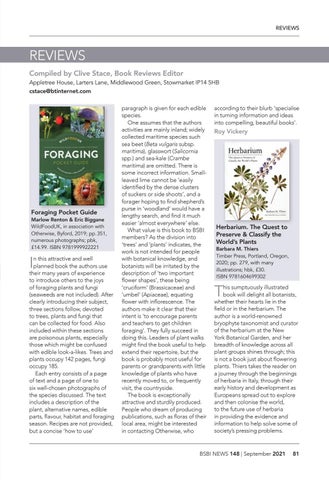REVIEWS
REVIEWS Compiled by Clive Stace, Book Reviews Editor
Appletree House, Larters Lane, Middlewood Green, Stowmarket IP14 5HB cstace@btinternet.com
Foraging Pocket Guide
Marlow Renton & Eric Biggane WildFoodUK, in association with Otherwise, Byford, 2019; pp. 351, numerous photographs; pbk, £14.99. ISBN 9781999922221
I
n this attractive and well planned book the authors use their many years of experience to introduce others to the joys of foraging plants and fungi (seaweeds are not included). After clearly introducing their subject, three sections follow, devoted to trees, plants and fungi that can be collected for food. Also included within these sections are poisonous plants, especially those which might be confused with edible look-a-likes. Trees and plants occupy 142 pages, fungi occupy 185. Each entry consists of a page of text and a page of one to six well-chosen photographs of the species discussed. The text includes a description of the plant, alternative names, edible parts, flavour, habitat and foraging season. Recipes are not provided, but a concise ‘how to use’
paragraph is given for each edible species. One assumes that the authors activities are mainly inland; widely collected maritime species such sea beet (Beta vulgaris subsp. maritima), glasswort (Salicornia spp.) and sea-kale (Crambe maritima) are omitted. There is some incorrect information. Smallleaved lime cannot be ‘easily identified by the dense clusters of suckers or side shoots’, and a forager hoping to find shepherd’s purse in ‘woodland’ would have a lengthy search, and find it much easier ‘almost everywhere’ else. What value is this book to BSBI members? As the division into ‘trees’ and ‘plants’ indicates, the work is not intended for people with botanical knowledge, and botanists will be irritated by the description of ‘two important flower shapes’, these being ‘cruciform’ (Brassicaceae) and ‘umbel’ (Apiaceae), equating flower with inflorescence. The authors make it clear that their intent is ‘to encourage parents and teachers to get children foraging’. They fully succeed in doing this. Leaders of plant walks might find the book useful to help extend their repertoire, but the book is probably most useful for parents or grandparents with little knowledge of plants who have recently moved to, or frequently visit, the countryside. The book is exceptionally attractive and sturdily produced. People who dream of producing publications, such as floras of their local area, might be interested in contacting Otherwise, who
according to their blurb ‘specialise in turning information and ideas into compelling, beautiful books’.
Roy Vickery
Herbarium. The Quest to Preserve & Classify the World’s Plants
Barbara M. Thiers Timber Press, Portland, Oregon, 2020; pp. 279, with many illustrations; hbk, £30. ISBN 9781604699302
T
his sumptuously illustrated book will delight all botanists, whether their hearts lie in the field or in the herbarium. The author is a world-renowned bryophyte taxonomist and curator of the herbarium at the New York Botanical Garden, and her breadth of knowledge across all plant groups shines through; this is not a book just about flowering plants. Thiers takes the reader on a journey through the beginnings of herbaria in Italy, through their early history and development as Europeans spread out to explore and then colonise the world, to the future use of herbaria in providing the evidence and information to help solve some of society’s pressing problems.
BSBI NEWS 148 | September 2021
81

















